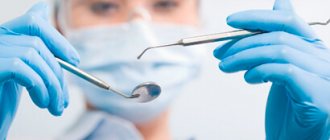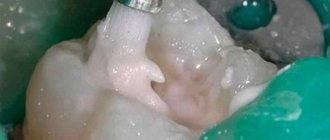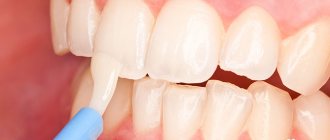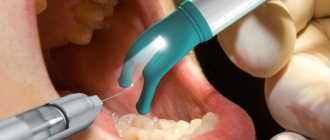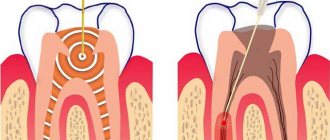Indications and contraindications for molar tooth extraction
It is impossible to determine the indications for the removal of molars in absentia; this requires an examination by an experienced dentist. Recommendations for carrying out extraction are:
- purulent periostitis when it is impossible to drain exudate through the root canal, abscess, phlegmon;
- purulent-inflammatory periodontal diseases, cystic formations, the presence of a tumor;
- longitudinal axial fracture of the dental crown, pulp exposure;
- destruction of the crown, excluding its reconstruction;
- incorrect position of the tooth, as a result of which the mucous membrane is injured or it is impossible to install an orthopedic prosthesis;
- diseases in which destructive changes in bone tissue occur;
- advanced inflammation of the paranasal sinuses, sinusitis.
There are the following contraindications for removal:
- exacerbation of cardiovascular diseases (pre-infarction condition, angina pectoris, arrhythmia, hypertension);
- acute respiratory viral diseases (including influenza and sore throat);
- general diseases of the body (renal failure, pancreatitis, infectious hepatitis);
- damage to the nervous system;
- the presence of neoplasms, hemophilia, leukemia, radiation sickness;
- the first and last months of pregnancy;
- inflammatory dental diseases (gingivitis, stomatitis);
- exhaustion of the patient’s body, dystrophy;
- alcohol intoxication.
Only a doctor has the right to make a decision about removal, carefully weighing all the pros and cons.
Contraindications to the procedure
The extraction procedure (that’s what it’s officially called) has its limitations. It should be noted that almost all contraindications are relative, which means that after eliminating limiting factors, removal can be carried out. These phenomena and conditions include the following:
- acute infectious diseases,
- blood clotting disorders,
- first and last trimester of pregnancy,
- 2 days before and after menstruation,
- diabetes in an uncompensated stage,
- pathologies of the heart and blood vessels,
- mental illnesses in aggravation.
It is not advisable for pregnant women to perform the procedure.
Sometimes emergency removal is required, and then there is simply no time left to eliminate the above-mentioned obstacles. In this case, the doctor takes on additional risk and performs the procedure as carefully as possible. It is better if it is a truly experienced and qualified dental surgeon.
How the removal process occurs (video)
Before removing a diseased tooth, the doctor must take an x-ray to determine the location of the roots. Removal takes place with an anesthetic injection.
The doctor carefully separates the gum, grabs the tooth with forceps and begins to pull it out, rocking or twisting it, depending on the number of roots. After this, you can pull the tooth out of the alveoli. Removing the lower and upper teeth is not much different; the upper molars are somewhat more difficult to grasp correctly.
«
In more advanced cases, the doctor can divide the dental crown into pieces using a drill and tear them apart. This method helps protect the jaw from damage.
When removing an impacted tooth or root fragments, it is first necessary to cut the mucous membrane, free access to the dental crown, and then begin pulling out. This complex removal is often performed under general anesthesia.
Removal of a molar tooth with a cyst requires a highly qualified dental surgeon and is performed under both local and general anesthesia.
Two days after removal, it is necessary to examine the patient and do a control x-ray to exclude the presence of “forgotten” root fragments in the jaw.
Tooth structure
The teeth are located on the upper and lower jaws. They consist of hard and soft tissues.
Solid:
- tooth enamel – the outer shell that protects the tooth;
- dentin – hard tissue, the basis of the entire tooth;
- Dental cement is the tissue covering the neck and root of the tooth.
The soft pulp includes the loose tissue inside the dental cavity, which has a large number of vessels, both blood and lymphatic, and nerve endings.
Anatomically, a tooth can be distinguished into three parts:
- crown - the part protruding above the gum;
- root - a part located deep in the alveolus of the gum;
- neck of the tooth - part of the actual transition of the tooth enamel into cement, that is, the place in the gap between the root and the crown.
Is it painful to remove a molar tooth, pain after removal
The pain of extraction is a thing of the past - modern painkillers can make the process completely painless, even when removing a tooth with a nerve. The patient is more likely to be concerned about pain after removal.
It is impossible to unequivocally answer the question of how much the gums hurt after such traumatic manipulations. The pain is quite strong at first, but later it will be less intense.
The doctor will definitely recommend an effective pain reliever for the first time.
You should pay attention to the nature of the pain: if it intensifies, becomes “knocking”, tugging, this is a signal about the beginning of dangerous suppuration of the hole. You need to see a doctor as soon as possible.
Is it possible to perform prosthetics immediately after root removal?
Single-stage implantation is a technology that allows you to restore a tooth immediately after its extraction. This technique makes it possible to significantly reduce treatment and restore the aesthetics and functionality of your smile in the shortest possible time. This concept includes immediate loading protocols, but in some cases a classic implant is fixed using standard two-stage technology.
With single-stage implantation, implants are installed in the socket immediately after tooth extraction
However, today experts prefer one-stage methods. According to the results of numerous clinical studies, implantation using a one-stage technology immediately after tooth extraction protects bone tissue from atrophy and reduces treatment time with a guarantee of long-term results of up to 96%1.
“I needed to remove one decayed tooth, but the problem was that it was in sight. I wanted to do everything right, but I was very worried that I would have to walk around with a hole while the implant took root. And then I came to you, and they offered me a one-step implantation. The tooth was carefully removed and an implant with a crown was immediately placed in its place. The procedure went quickly, completely without pain, although I still had doubts about local anesthesia and thought about going under anesthesia. I am immensely grateful to your specialists!”
Lyubov Vyacheslavovna K., 46 years old, review on the website of a Moscow dental clinic
After extraction, restoration of bone tissue is not required - the implant is implanted into the vacated socket and can be additionally strengthened with bone replacement powder. In this case, a temporary crown is immediately fixed, and after a few months, when the implant has fused with the jawbone, it is replaced with a permanent single prosthesis. A temporary crown is created from a lightweight material – plastic. It turns out to be slightly shorter than the neighboring elements, which avoids intense mechanical impact and displacement of the artificial root.
Important! Single structures are fixed only in place of single-rooted front teeth (incisors and canines), which are not subject to intense exposure. Their main function is to restore the aesthetics of the row.
The photo shows a diagram of a tooth implantation with immediate loading.
But this procedure is not possible in all cases. Implantation is a serious operation that cannot be performed without careful preparation. It is necessary to study the clinical picture, exclude possible contraindications, and select an implant model. Most patients turn to dentistry when emergency removal is required, and there is simply no time left for preparation.
Features of molar removal during pregnancy
During pregnancy, it is advisable to avoid any surgical interventions that negatively affect the condition of the expectant mother. Ideally, it is best to treat everything prophylactically before the onset of an interesting condition. If your tooth hurts while waiting for your baby, pay attention to the following points:
- Removal is not recommended in the first and last months, when the baby is most vulnerable.
- There is no need to expose the body to unnecessary stress, if we are talking about a planned operation, it is better to wait until the birth of the child.
- Any intervention should be carried out solely for health reasons.
- You definitely need to warn your doctor about your situation, he will select the most harmless anesthetic that does not penetrate the placental barrier.
If tooth extraction is complicated, it is advisable to do it in a hospital under the supervision of experienced doctors; during the first 2-3 days, the temperature may rise, which is extremely undesirable for expectant mothers.
Features of implantation of the 6th lower tooth
The six of the lower jaw bears more loads during chewing than the upper jaw. Therefore, implants are selected taking this fact into account - wide and of sufficient length. The nuances of implantation from below:
- easier to carry out than on the top;
- implants take root faster - in 2-4 months, since the jawbone is denser and anatomically higher;
- but there is a risk of damage to the trigeminal nerve if the protocol is not followed, which is complicated by numbness of the chin and lips.
If the bone is small in height, then a preliminary operation is performed to increase it. The gum is peeled off, bone material is added, and a resorbable membrane is applied to secure it. Recovery takes up to six months.
Without preliminary bone grafting, surgery is possible if the atrophy is moderate. In this case, our Center uses bone growth stimulants. They are fixed to the neck of the artificial root during its installation and trigger the processes of bone tissue regeneration. In this case, implant healing and bone tissue growth occur simultaneously.
Molar tooth extraction in children
A child’s molar can be either a baby tooth or a permanent tooth; depending on this, treatment tactics are differentiated. If the permanent one has already begun to grow, and the milk tooth has not yet fallen out, but is already wobbly, the pediatric dentist will definitely advise removing the milk tooth that is interfering with normal eruption. If a baby’s permanent molar tooth hurts, the doctor will give preference to conservative treatment in order to preserve the integrity of the dentition.
Premature extraction of baby teeth is undesirable; it negatively affects the formation of the bite.
Clear indications for extraction in children are:
- the presence of a granuloma or dental root cyst.
- inflammation of the tooth root, mandibular nerve.
- complete destruction of the crown.
Baby teeth. Initial development
Deciduous teeth are the first set of teeth. At birth they are absent, but are already embedded in the gums. At the 7th week of embryo formation, in the area of future processes of the alveoli, the epithelium thickens, which in turn begins to grow in the form of an arcuate plate into the mesenchyme.
Teething begins after birth, and always occurs in a certain sequence.
As a rule, the primary incisors, the front teeth, erupt first, between 4 and 6 months of a child’s life. But the deciduous premolars are the last ones, both in terms of their location in the deciduous occlusion and in the order of appearance, and erupt within a period of up to 3 years. By this age, the child has all 20 teeth.
But you shouldn’t focus strictly on age. Teeth eruption, loss and replacement depend on many factors, including genetics. Therefore, the process may take place a little earlier, or vice versa a little later.
Then the formation of a permanent bite begins. And the first erupting tooth, which will be a molar, is a six, a permanent tooth, the 1st molar. There is no predecessor in his place. Next, the 2nd molar, or the seventh tooth, begins to appear.
Next, the replacement of all milk teeth, formed by that time, with permanent ones begins, and, as a rule, the process proceeds in the same order as the eruption of milk teeth, that is, starting from the front incisors and ending with the permanent premolars (4th and 5th m tooth).
The replacement process ends between the ages of 8 and 12 years. This is a long period and, as mentioned above, depends on many factors.
And starting from the 1st molar, or the 6th (tooth six), all the new teeth make parents worry about their health and the correct formation of the child’s bite.
Possible consequences and complications
Extraction, like any operation, can cause a negative reaction from the body. If your cheek is swollen, your throat hurts, or there is a sharp throbbing pain in the socket, there is a high probability of an inflammatory process.
Early complications:
- fainting, shock, collapse;
- fracture, dislocation of the jaw;
- perforation of the maxillary sinus (when removing an upper molar or premolar), falling of root fragments into the gum;
- trauma, dislocation, fracture of an adjacent or opposite tooth;
- severe bleeding, hematoma formation.
Late complications:
- inflammation of the alveoli (alveolitis);
- inflammation of peripheral nerves (neuritis);
- restriction of jaw movement (muscle contracture).
By contacting a specialist in a timely manner, the consequences of removal can be minimized.
Symptoms of molar eruption
As a rule, the sixth teeth emerge from the molars first.
During the teething period, the immune system's defenses are weakened, and the following symptoms similar to colds may appear:
- elevated temperature;
- runny nose;
- and most importantly – increased salivation.
And since the teeth appear in pairs, that is, the canine on the upper right side erupts at the same time as the canine on the upper left side, then the six teeth in children come out together, which can aggravate the process.
These teeth are the very first molars to erupt. To ease the symptoms of a small child and relieve some of the pain, you can massage the gums with your finger, but be sure to wash your hands thoroughly before doing so. Otherwise, it will not be difficult to get an infection. And older children can chew hard vegetables or fruits: apples, carrots and other hard foods.
Is it possible to remove it at home?
Removing a tooth on your own is dangerous; at home, it is difficult to ensure sterility, numb the gums, ensure that the root is completely pulled out, and prevent blood loss and other complications. You can remove only a very loose tooth yourself without risk to your health.
Typically, children's loose baby teeth are removed at home. It is important to remove food debris and thoroughly disinfect the oral cavity. You need to tightly grasp the tooth with your fingers wrapped in sterile gauze, loosen it well and only then pull it. If after the second attempt you are unable to pull out the tooth, entrust this difficult manipulation to an experienced dentist without risking your health.
If the tooth comes out of the socket easily, you need to press the gauze swab firmly onto the wound to stop the bleeding and hold it for 30-40 minutes. You should refrain from eating for two hours.
If any unpleasant discomfort occurs, it is advisable to consult a dentist as soon as possible to prevent complications from developing.
Finally, I would like to remind you: simple preventive measures will allow you to keep your smile snow-white and your teeth healthy and strong for many years.



